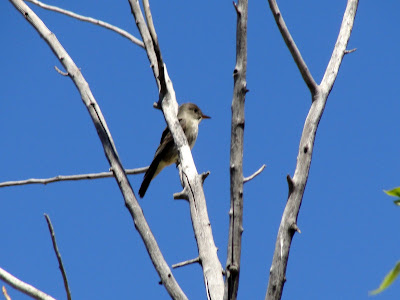
We hiked to the top of Lake Mountain last week, a distance of 2 miles and 1000 feet elevation gain.
Marsh Peak (12,240 feet) comes into view, still covered with snow.

On top of Lake Mountain (9000 feet), snowbanks still remain in the shadows.

This gray-headed, dark-eyed junco dances in and out of icy water from the snowmelt, hunting for seeds or insects.

This is probably the type of bird whose nest we found near the same aspen groves last July.

Buttercups are the only flower blooming at 9000 feet elevation, so far. Spring is slow to arrive in the high country. The aspens haven't leafed out yet.

Gull Lake reflects clouds and sky. We'll come back in a couple of weeks, maybe on horseback, to see what flowers are blooming then.
 Okay, we know these guys love a PBJ sandwich. (Photo from last November)
Okay, we know these guys love a PBJ sandwich. (Photo from last November) But who would've guess that this little guy (photo taken yesterday) would be enamored of the same lunch choice?
But who would've guess that this little guy (photo taken yesterday) would be enamored of the same lunch choice? I don't know what kind of bug this is, but he's kind of cute, don't you think? And he has good taste in food.
I don't know what kind of bug this is, but he's kind of cute, don't you think? And he has good taste in food.
































 For more cute critters, click
For more cute critters, click 














